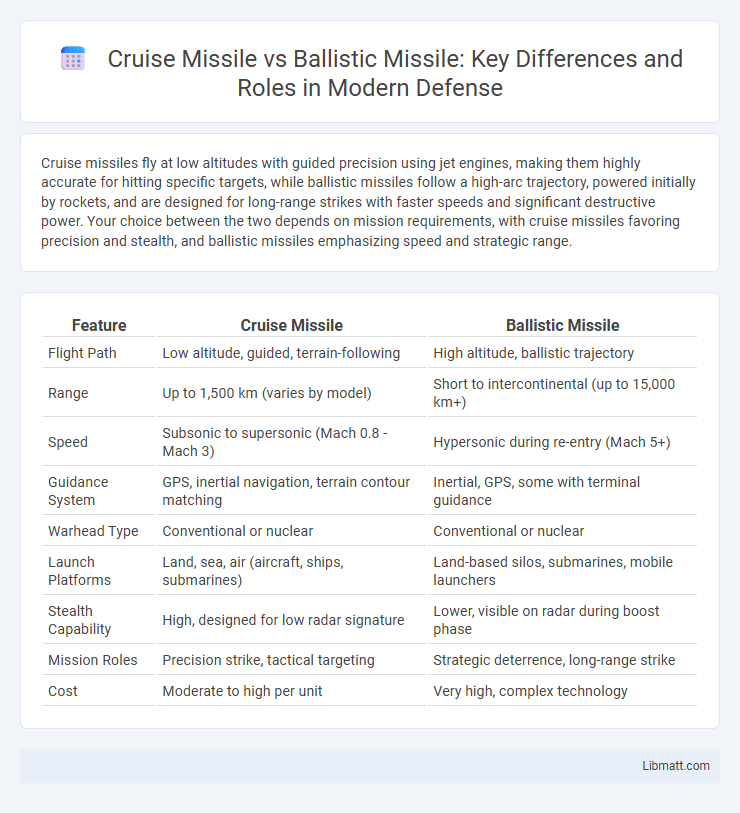Cruise missiles fly at low altitudes with guided precision using jet engines, making them highly accurate for hitting specific targets, while ballistic missiles follow a high-arc trajectory, powered initially by rockets, and are designed for long-range strikes with faster speeds and significant destructive power. Your choice between the two depends on mission requirements, with cruise missiles favoring precision and stealth, and ballistic missiles emphasizing speed and strategic range.
Table of Comparison
| Feature | Cruise Missile | Ballistic Missile |
|---|---|---|
| Flight Path | Low altitude, guided, terrain-following | High altitude, ballistic trajectory |
| Range | Up to 1,500 km (varies by model) | Short to intercontinental (up to 15,000 km+) |
| Speed | Subsonic to supersonic (Mach 0.8 - Mach 3) | Hypersonic during re-entry (Mach 5+) |
| Guidance System | GPS, inertial navigation, terrain contour matching | Inertial, GPS, some with terminal guidance |
| Warhead Type | Conventional or nuclear | Conventional or nuclear |
| Launch Platforms | Land, sea, air (aircraft, ships, submarines) | Land-based silos, submarines, mobile launchers |
| Stealth Capability | High, designed for low radar signature | Lower, visible on radar during boost phase |
| Mission Roles | Precision strike, tactical targeting | Strategic deterrence, long-range strike |
| Cost | Moderate to high per unit | Very high, complex technology |
Introduction: Cruise Missiles vs Ballistic Missiles
Cruise missiles maintain a low-altitude, guided flight path powered by jet engines, offering precision strikes over long distances with the ability to maneuver mid-flight. Ballistic missiles follow a high-arc trajectory, propelled by rocket engines, designed primarily for delivering nuclear or conventional warheads over extended ranges at high speeds. Understanding the operational differences between these missile types can enhance your strategic planning for defense or military applications.
Definition and Core Differences
Cruise missiles are guided weapons that fly at low altitudes and maintain a constant speed using aerodynamic lift, allowing precise targeting over long distances. Ballistic missiles follow a high-arc, unpowered trajectory after an initial rocket-powered boost, relying on gravity to reach their targets, often delivering nuclear payloads. Your choice between these missile types depends on the mission's need for precision, speed, and range.
Guidance and Navigation Systems
Cruise missiles utilize advanced GPS, INS (Inertial Navigation System), and terrain contour matching (TERCOM) for precise, low-altitude flight paths, allowing them to navigate complex terrain and avoid radar detection. Ballistic missiles rely primarily on inertial guidance systems during the powered phase and may incorporate satellite navigation for mid-course corrections, but their ballistic trajectory limits in-flight maneuvering accuracy. Understanding these distinct guidance and navigation systems enables you to appreciate the varying strategic uses of each missile type in modern warfare.
Speed and Flight Profiles
Cruise missiles travel at subsonic or low supersonic speeds, flying at low altitudes with a terrain-hugging flight profile for stealth and precision. Ballistic missiles achieve much higher speeds, often multiple times the speed of sound, with a steep, arcing trajectory exiting the atmosphere before re-entering toward their targets. Your choice between these weapons depends on the need for speed and the flight path characteristics suited to the mission's strategic goals.
Launch Platforms and Flexibility
Cruise missiles are launched from a variety of platforms including ships, submarines, aircraft, and ground vehicles, offering exceptional operational flexibility and precision targeting over long distances at low altitudes. Ballistic missiles are typically launched from fixed silos, mobile launchers, or submarines, optimized for delivering payloads on high-arc trajectories to strategic targets with rapid global reach. Your choice between these missile types depends on mission requirements, with cruise missiles providing versatile deployment options and ballistic missiles offering swift, high-impact strike capabilities.
Range and Target Accuracy
Cruise missiles typically have a range of up to 1,500 miles with high target accuracy due to their ability to fly at low altitudes using GPS and terrain mapping for navigation. Ballistic missiles can reach much greater ranges, often exceeding 3,000 miles, but their target accuracy varies significantly depending on missile type and guidance technology. Advanced ballistic missile systems employ inertial navigation and satellite guidance to improve precision, though cruise missiles remain superior for striking specific, fixed targets with minimal collateral damage.
Payload Capabilities
Cruise missiles typically carry smaller, precision-guided payloads ranging from 200 to 2,000 pounds, designed for targeted strikes with high accuracy. Ballistic missiles can deliver significantly larger warheads, including single or multiple independently targetable reentry vehicles (MIRVs), with payloads ranging from several hundred kilograms to several tons. The payload versatility of ballistic missiles allows for strategic nuclear or conventional strikes over long distances, whereas cruise missiles excel in tactical, low-altitude attacks with conventional warheads.
Defense Evasion and Survivability
Cruise missiles leverage low-altitude flight and terrain-following technology to evade radar detection, enhancing their survivability against air defense systems. Ballistic missiles rely on high-speed, high-altitude trajectories that reduce interception windows but are vulnerable during boost and reentry phases. Your defense strategy must account for these differences to optimize detection and interception capabilities effectively.
Strategic and Tactical Applications
Cruise missiles offer precise, low-altitude flight paths, making them ideal for tactical strikes against specific targets with minimal radar detection, while ballistic missiles follow a high-arc trajectory suited for strategic long-range attacks carrying larger warheads. You can deploy cruise missiles effectively for battlefield support and limited-range missions, whereas ballistic missiles serve broader strategic deterrence by threatening distant targets and infrastructure. The distinct flight profiles and payload capacities define their complementary roles in modern military operations.
Future Developments and Trends
Future developments in cruise missiles emphasize increased stealth, enhanced precision through advanced guidance systems, and extended range enabled by improved propulsion technologies. Ballistic missile trends focus on greater speed, hypersonic capabilities, and enhanced maneuverability to evade missile defenses, with artificial intelligence integration for adaptive targeting. Your defense strategy must adapt to these evolving technologies to maintain effective deterrence and countermeasure capabilities.
cruise missile vs ballistic missile Infographic

 libmatt.com
libmatt.com